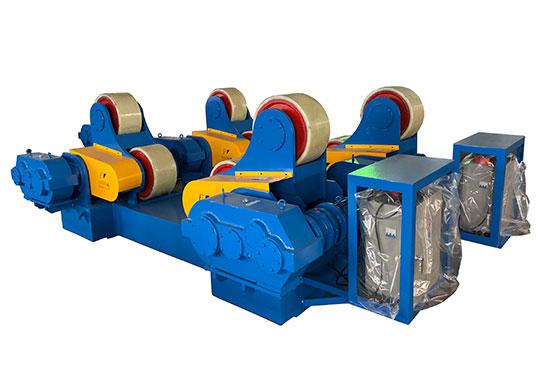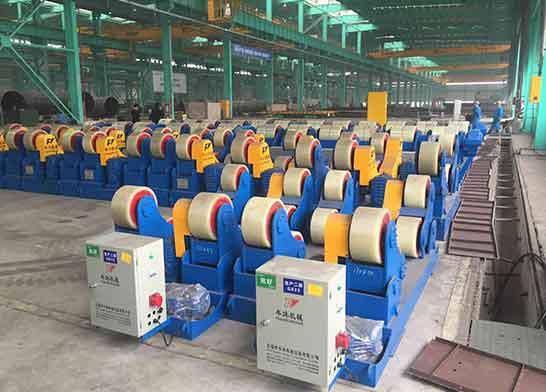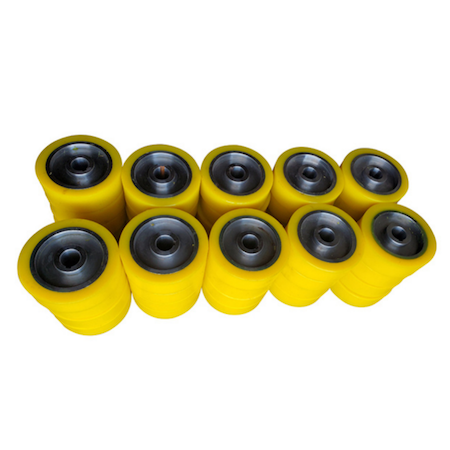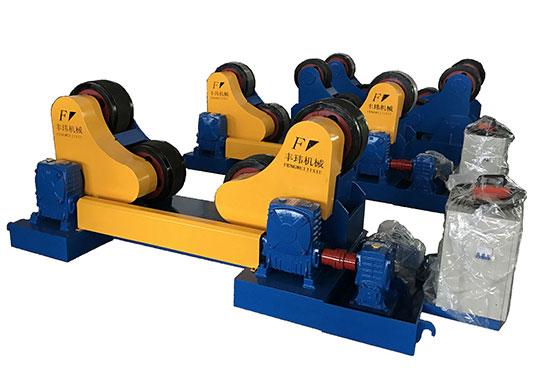Welding rollers have a variety of styles, mainly to meet the welding needs of various specifications and irregular welding workpieces. The common ones are self-adjusting, adjustable, flat car, tiltable, and anti-axial movement. General welding rollers can be used for welding, polishing, rubber lining, and assembly of cylindrical cylinders, while self-adjusting rollers can be adjusted according to the size of the cylinder, adjustable rollers can be adjusted by screw rods for foam machinery, and screws are adjusted in steps, etc. Controlled by an AC frequency converter, the line speed is digitally displayed, advanced and reliable, FENGWEI welding equipment can also design and customize various types of rollers according to user needs and industry needs.

Self-adjusting welding rollers
The self-adjusting rollers produced by FENGWEI are composed of two sets of main and auxiliary machines, namely active rollers and passive rollers. The self-adjusting series of active rollers and passive rollers each have four rollers. The rollers are made of an inner iron core and an outer rubber structure. It has the characteristics of durability and no vibration during use. The operation of the active roller is synchronously driven by the speed-regulating motor through two worm gear reduction boxes, and the speed-regulating controller is used to realize the function of infinitely variable speed.
Not only that, during the operation of the entire welding roller, the mechanical transmission noise is low, the workpiece rotation is stable, and it has a good welding auxiliary function. The linear speed of the workpiece rotation is 5-70m/h (for infinitely variable speed). The frame is automatically adjusted when the diameter of the workpiece reaches a certain range. When the minimum diameter is reached, the lower wheels of each group of clamp frames are on the same horizontal line (rollers of different tonnages have different working ranges). The working range of the rollers of each tonnage shall not exceed the maximum diameter size.

Adjustable welding rollers
Fengwei adjustable welding roller is a displacement machine that drives the rotation of the weldment by means of the friction between the active roller and the weldment. The adjustable welding roller has only one roller part which is the driving roller part and the other is the driven roller part. The whole driving device adopts a variable frequency speed regulation motor, which drives the roller parts through the reducer, and drives the welding parts for welding rotation. The distance adjustment of the roller parts in each roller is done manually, according to the condition of the weldment, using the positioning bolt.

Technical requirements for the operation of welding rollers
The content analysis of the technical requirements during the welding roller operation is as follows:
1. The welding roller automatically adjusts the swing angle of the wheelset according to the diameter of the workpiece, and can automatically adjust the center. When matched with a welding manipulator and a welding power source, the inner and outer longitudinal seams and inner and outer circumferential seams of the workpiece can be welded.
2. The transmission noise is low and the workpiece rotates smoothly, which can realize the welding, polishing, rubber lining, and assembly of the cylindrical cylinder. The rotation speed of the roller should be stable and uniform. Crawling is not allowed.
3. It must have overvoltage protection, self-protection function, fault display and storage function, automatic air switch short-circuit protection, and preset parameters.
4. The heights of the main and driven rollers can be adjusted appropriately, and the assembly and welding of the cone and segmented unequal-diameter revolving bodies can also be carried out.
5. For some non-circular elongated welding parts, they can be clamped in a special ring clamp, or the welding operation can be carried out on the welding roller.
6. The self-adjusting roller adopts digital adjustment and display technology for the speed of the roller. The setting of the welding speed is very intuitive and accurate, which reduces the difficulty of operation for workers.
7. The manufacturing and assembly accuracy of the welding roller should meet the requirements of the 8-level accuracy in the national standard. Welding rollers should be made of high-quality steel. If a base of welded construction is used, a stress relief heat treatment must be performed after welding.
8. The welding roller must be equipped with a reliable conductive device, and the welding current is not allowed to flow through the bearing of the welding roller.
9. When the cylindrical workpiece is welded on the anti-axial movement roller, the axial movement of the workpiece during the whole welding process should be ≤±3mm.
10. The center distance of each pair of welding rollers must be adjusted according to the diameter of the cylindrical workpiece to ensure that the wrapping angle between the two rollers is 45° larger than 110°.
11. Equipped with 15m control cable, roller forward and reverse switch, near control, and remote control switch.
12.The rollers are preferably made of polyurethane or nitrile rubber.
















